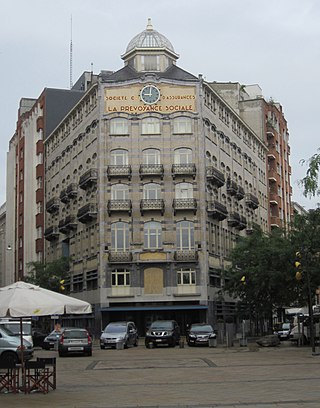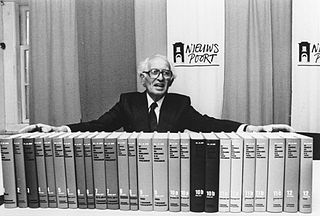
The NIOD Institute for War, Holocaust and Genocide Studies is an organisation in the Netherlands which maintains archives and carries out historical studies into the Second World War, the Holocaust and other genocides around the world, past and present. The institute was founded as a merger of the Netherlands Institute for War Documentation and the Center for Holocaust and Genocide Studies (CHGS).

Louis "Loe" de Jong was a Dutch historian who specialised in the Netherlands in World War II and the Dutch resistance.

The Dutch resistance to the German occupation of the Netherlands during World War II can be mainly characterized as non-violent, partly because, according to “Was God on Vacation?”, written by Jack van der Geest who was in the Dutch resistance during WWII, a 1938 Dutch law required all guns to be registered. When the Nazis entered, they found the registration list and went house-to-house knowing exactly what guns to demand. As a result, the Dutch resistance had no guns.
The Museum Card, also known as the Museumkaart in Dutch, is a personal card that grants free entry to approximately 400 museums in the Netherlands for one year. It is available for purchase at many of the larger participating museums or online, with a temporary card issued when purchased from the museum. While most museums offer free entry to Museum Card holders, some museums may charge an additional fee for special exhibitions, but not for general collections.

The Study and Documentation Centre for War and Contemporary Society, known by its combined French—Dutch acronym Cegesoma or CegeSoma, is a historical research institute and archive based in Anderlecht, Brussels in Belgium. It focusses on World War II and the contemporary history of Belgium. Since 2016 it has formed part of the Belgian State Archives. Its director is Nico Wouters.

The Chabot Museum is a museum dedicated to the Dutch painter and sculptor Hendrik Chabot in Rotterdam in the Netherlands. The museum is housed in a monumental villa in the Museumpark, near the Museum Boijmans van Beuningen and the Netherlands Architecture Institute.

The Kingdom of the Netherlands During World War II is the standard reference on the history of the Netherlands during World War II. The series was written by Loe de Jong (1914–2005), director of the Dutch Institute for War Documentation, and was published between 1969 and 1991. The series contains 14 volumes, published in 29 parts. De Jong was commissioned to write the work in 1955 by the Ministry of Education, Culture and Science. The first volume appeared in 1969, and de Jong wrote his last in 1988. The final volume, containing critique and responses, appeared in 1991.
Uğur Ümit Üngör is a Dutch–Turkish academic, historian, sociologist, and professor of Genocide studies, specializing as a scholar and researcher of Holocaust studies and studies on mass violence. He served as Professor of History at the Utrecht University and Professor of Sociology at the NIOD Institute for War, Holocaust and Genocide Studies.
The Bijzonder Gerechtshof was a special court that was established in the Netherlands to try defendants accused of committing high treason, treason and war crimes immediately after the country's liberation during the Second World War. There were 14,000 such cases, and 145 of them led to sentence of death. Only 42 of those cases actually led to an execution by a firing squad. They were the last instances of capital punishment in the Netherlands.

The Holocaust in the Netherlands was organized by Nazi Germany in occupied Netherlands as part of the Holocaust across Europe during the Second World War. The Nazi occupation in 1940 immediately began disrupting the norms of Dutch society, separating Dutch Jews in multiple ways from the general Dutch population. The Nazis used existing Dutch civil administration as well as the Dutch Jewish Council "as an invaluable means to their end". In 1939, there were some 140,000 Jews living in the Netherlands, among them some 24,000 to 25,000 German-Jewish refugees who had fled from Germany in the 1930s. Some 75% of the Dutch-Jewish population was murdered in the Holocaust. The 1947 census reported 14,346 Jews, or 10% of the pre-war population. This further decrease is attributed to massive emigration of Jews to the then British Mandate of Palestine. There is debate among scholars about the extent to which the Dutch public was aware of the Holocaust. Postwar Netherlands has grappled with construction the historical memory of the Holocaust and created monuments memorializing this chapter Dutch history. The Dutch National Holocaust Museum opened in March 2024.

Maria Janna "Marjan" Schwegman is a Dutch historian who was managing director of the NIOD Institute for War, Holocaust and Genocide Studies from March 2007 to 18 February 2016. Besides that, she is a professor in Politics and Culture in the 20th century at the faculty of Humanities at Utrecht University.

Jacoba van Tongeren was a resistance fighter, the founder and leader of Group 2000, a resistance group during the Second World War. Jacoba van Tongeren is the only woman to have created and led a resistance group during the war. In 1990, Yad Vashem honoured Jacoba van Tongeren as Righteous Among the Nations.

The Dutch: Nationaal Museum van Wereldculturen (NMVW) is an overarching museum organisation for the management of several ethnographic museums in the Netherlands, founded in 2014. It consists of the Tropenmuseum in Amsterdam, the Afrika Museum in Berg en Dal, and the Museum Volkenkunde in Leiden. The National Museum of World Cultures works in close cooperation with the Wereldmuseum in Rotterdam. It is also part of nation-wide Dutch organisations for research into provenance studies and projects of restitution of cultural heritage to countries of origin, like the former Dutch colony in today's Indonesia.

The Vrije Groepen Amsterdam was a federation of Dutch resistance groups in Amsterdam during the final years of World War II. The VGA was founded in late 1943 to coordinate the activities of Amsterdam's resistance groups. The groups counted some 350 members, about a fifth of whom had a Jewish or part-Jewish background. The VGA focused primarily on hiding Jews from the Nazis and caring for Jews in hiding. Their activities included distributing falsified identification documents, as well as ration cards and financial support, to Jews and others in hiding and to members of the resistance movement.
Anarchism in the Netherlands originated in the second half of the 19th century. Its roots lay in the radical and revolutionary ideologies of the labor movement, in anti-authoritarian socialism, the free thinkers and in numerous associations and organizations striving for a libertarian form of society. During the First World War, individuals and groups of syndicalists and anarchists of various currents worked together for conscientious objection and against government policies. The common resistance was directed against imperialism and militarism.

Maria Aloysia Löwenfels PHJC, was a German religious sister. She converted from Judaism to Catholicism. In 1936, she fled to the convent of the Poor Handmaids of Jesus Christ in Lutterade, Netherlands. In 1938, she was confirmed as a novice. On 9 August 1942, she was murdered in the gas chambers of concentration camp Auschwitz-Birkenau. In 2015, the Roman Catholic Diocese of Limburg announced that a beatification process had been started.

The Allied bombings of Amsterdam-Noord took place in July 1943 during the German occupation of the Netherlands in World War II. Three strategic bombing attacks by Allied Forces were aimed at the former Fokker Aircraft Factory in the northern part of Amsterdam, which was of interest as the factory was confiscated by the Nazis and employees were forced to produce aircraft for the Luftwaffe. However, only 7 out of the 326 bombs from these three airstrikes hit their target, while the others fell on the surrounding residential area, resulting in the loss of more than 206 lives in total. The attacks were the most damaging and deadly bombardment of Amsterdam during the Second World War, and the most disastrous airstrike the city has ever endured. As these were Allied attacks, the losses and trauma caused by the event have always been a sensitive and painful topic for the citizens of Amsterdam-Noord.

The Dutch National Holocaust Museum is the first official museum on the Holocaust in the Netherlands. It is located in an historic building in the Jewish Cultural Quarter of Amsterdam, near a former child care center that played a role in rescuing Jewish children. The museum tells the story of the Holocaust through the lives of individual victimised men, women, and children. There is a floor-to-ceiling display of all the laws limiting and obliterating the rights of Jews in the Netherlands, who since the eighteenth century had been Dutch citizens with equal rights.














